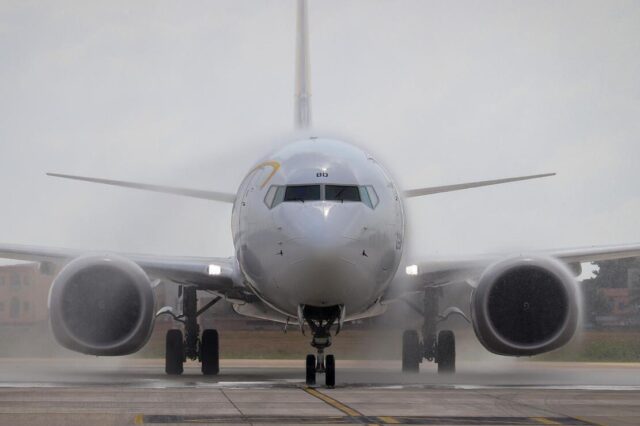64% of UK public haven’t heard of ‘flying taxis’: NATS
September 24, 2024

A recent public perception study by NATS highlighted that 64% of the UK public haven’t heard of the flying taxi idea – a figure much in line with last year’s survey. With general awareness of the concept having apparently plateaued, just what could be done to support wider understanding of eVTOLs as they move closer to certification and entry into service?
Only a 34% familiarity rate
The annual NATS 2024 Aviation Index (conducted with the support of research partners at Ipsos) illustrated that, perhaps surprisingly, only 36% of UK respondents were aware of the flying taxi concept; something that developers such as Bristol-headquartered Vertical Aerospace are working hard to address.
“We know the three main challenges facing the eVTOL sector are around technology, regulation and public perception,” illustrated a spokesperson from Vertical Aerospace in response to the NATS survey. “While we are making huge strides with the first two of these, it is inevitable the third will take more time”.
However, the 64% figure is not exactly a surprise, explained James Richmond, head of future flight at AtkinsRéalis (which also leads the Advanced Mobility Ecosystem Consortium). “While AAM has gained traction in certain sectors, public awareness is still growing as the technology progresses towards certification and commercial phases. Globally, this figure will likely vary across regions depending on the extent of eVTOL developments, committed routes, and media/social attention”.
Of those who’ve heard: 30% ‘not at all likely’ to use
Further insight from the NATS study indicated that of those who were aware of the flying taxi concept, 30% indicated they were ‘not at all likely’ to use them; up from 27% of 2023 recipients. (Only 11% of people stated they were ‘very likely’ to use the service, only one percentage point up from last year’s findings).
So why this apparent reticence? Citing the need for ensuring the public can “engage with the technology in meaningful ways,” Richmond continued: “Raising public awareness through mainstream media and social platforms will help, but we also see earlier use cases of AAM, such as small-medium drones, playing a role. These high-social-benefit applications will demonstrate the practical value of AAM and help to build public trust”.
The NATS survey supported this view, adding that although support for the routine use of drones continues to build on last year’s results, “conversely the idea of jumping on an eVTOL is less appealing to most, and shows why public acceptance must be a priority if advanced air mobility is ready to take off”. A spokesperson for NATS also noted that the organisation is “heavily involved in supporting things like the government’s future flight challenge,” with NATS having “conducted a series of in depth simulations over past 12 months looking at how we would integrate BVLOS drone operations and eVTOLs into UK airspace”.
Money talks
Of those unlikely to use a flying taxi, 50% cited safety concerns, a factor trumped only by cost. Although admittedly 42% of survey respondents were planning to fly less in coming months for financial reasons, 56% of respondents believe eVTOLs will be too expensive outright.
“While cost is a valid concern, it’s important to emphasise that eVTOL technology, like many early-stage innovations, will become more accessible as it matures,” said Richmond. “Additionally, eVTOL designs offer advantages over traditional aircraft for similar applications, such as quieter operation, less maintenance and greater autonomy, which could aid in scalability and ultimately lower prices over time”.
While focus group research by Connected Places Catapult revealed that although there is an overall impression of luxury attached to eVTOLs as a concept, other members of the public recognised the potential for public services (such as emergency response use cases). However, whether or not acceptance for medical use cases (for example) will translate into public support for commercial services (if the general public still deem the ticket price to be too high) remains to be seen.
Driving positive engagement
“We strongly believe the upcoming demonstrations and opening of the living lab [scheduled for the end of 2024] will raise public awareness by bringing the technology to life and give the public a firsthand experience of AAM. The demonstrations are designed not only to test the technology but also to engage communities, the media, and stakeholders, creating a dialogue around the future of air mobility,” concluded Richmond.
Despite arguably suboptimal public perception as of the present moment, Vertical agreed that “this dynamic will shift as more people have the chance to see or experience the technology themselves,” adding: “We have no doubt excitement about eVTOLs will build as we work towards their introduction to UK skies and look forward to offering a glimpse of that with our public demonstrations”.
Alongside public demonstration flights (something Vertical Aerospace are working to help facilitate at the Bicester ‘living lab’), Richmond also highlighted that “partnerships with trusted institutions – whether government bodies or established transport organisations – can help lend credibility to the concept such as the UKRI’s support of the Consortium”.
Richmond concluded with the words of a Londoner, who observed: “It’s early days. Remember 120 years ago, the Wright Brothers had difficulty getting people to invest in their aircraft. We don’t like roads being built. There are lobbies to stop roads and aircraft being built. And we can’t keep using fossil fuels, there’s a finite amount. I’m quite excited by [flying taxis]. I realise it’s expensive, but remember in the 1950s, only rich people could fly. Nowadays people are flying two, three times a year and they’re ordinary people”.
















